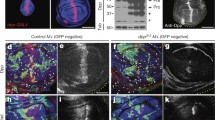Abstract
AFTER cellularization of the Drosophila embryo, positional differences within each primordial segment are maintained and elaborated by processes that require cell interactions. The best-documented examples1,2 of such intercellular signalling are the mutual interactions between neighbouring cells expressing the homeodomain protein engrailed3 and the secreted glycoprotein encoded by wingless4, the Drosophila homologue of the murine Wnt-1 gene5. Little is known about the molecular basis of these signalling mechanisms but the activities of several other genes, notably patched and hedgehog, have been implicated in the process1,2. Here we show that the role of patched in positional signalling is permissive rather than instructive, its activity being required to suppress wingless transcription in cells predisposed to express the latter. According to this view, expression of wingless is normally maintained only in those cells receiving an extrinsic signal, encoded by hedgehog, that antagonizes the repressive activity of patched. We suggest that the patched protein may itself be the receptor for this signal, implying that this is an unusual mechanism of ligand-dependent receptor inactivation.
Similar content being viewed by others
References
Martinez-Arias, A., Baker, N. E. & Ingham, P. W. Development 103, 157–170 (1988).
DiNardo, S., Sher, E., Heemskerk-Jongens, J., Kassis, J. & O'Farrell, P. H. Nature 332, 604–609 (1988).
Fjose, A., McGinnis, W. J. & Gehring, W. J. Nature 313, 284–289 (1985).
van den Heuvel, M., Nusse, R., Johnston, P. & Lawrence, P. A. Cell 59, 739–749 (1989).
Rijsewijk, F. et al. Cell 50, 649–657 (1987).
DiNardo, S., Kuner, J. M., Theis, J. & O'Farrell, P. H. Cell 43, 59–69 (1985).
Baker, N. E. EMBO J. 6, 1765–1774 (1987).
Howard, K. & Ingham, P. Cell 44, 949–957 (1986).
DiNardo, S. & O'Farrell, P. H. Genes Dev. 1, 1212–1225 (1987).
Ingham, P. W., Baker, N. E. & Martinez-Arias, A. Nature 331, 73–75 (1988).
Nüsslein-Volhard, C. & Wieschaus, E. Nature 287, 795–801 (1980).
Ingham, P. W. Nature 335, 25–34 (1988).
Nakano, Y. et al. Nature 341, 508–513 (1989).
Hidalgo, A. & Ingham, P. Development 110, 291–302 (1990).
Martinez-Arias, A. Trends Genet. 5, 262–267 (1989).
Hooper, J. & Scott, M. P. Cell 59, 751–765 (1989).
Campos-Ortega, J. A. & Hartenstein, V. The Embryonic Development of Drosophila melanogaster (Springer, Berlin, 1985).
Mohler, J. Genetics 120, 1061–1072 (1988).
Hama, C., Ali, Z. & Kornberg, T. B. Genes Dev. 4, 1079–1093 (1990).
Thummel, C. S., Boulet, A. M. & Lipshitz, H. D. Gene 74, 445–456 (1988).
Tautz, D. & Pfeifle, C. Chromosoma 98, 81–85 (1989).
Lewis, E. B. Nature 276, 565–570 (1978).
Author information
Authors and Affiliations
Rights and permissions
About this article
Cite this article
Ingham, P., Taylor, A. & Nakano, Y. Role of the Drosophila patched gene in positional signalling. Nature 353, 184–187 (1991). https://doi.org/10.1038/353184a0
Received:
Accepted:
Issue Date:
DOI: https://doi.org/10.1038/353184a0
- Springer Nature Limited
This article is cited by
-
TnaA, a trithorax group protein, modulates wingless expression in different regions of the Drosophila wing imaginal disc
Scientific Reports (2023)
-
New insights into the GDF9-Hedgehog-GLI signaling pathway in human ovaries: from fetus to postmenopause
Journal of Assisted Reproduction and Genetics (2021)
-
Centrosome instability: when good centrosomes go bad
Cellular and Molecular Life Sciences (2021)
-
Exploring Sonic Hedgehog Cell Signaling in Neurogenesis: Its Potential Role in Depressive Behavior
Neurochemical Research (2021)
-
Structures of human Patched and its complex with native palmitoylated sonic hedgehog
Nature (2018)





